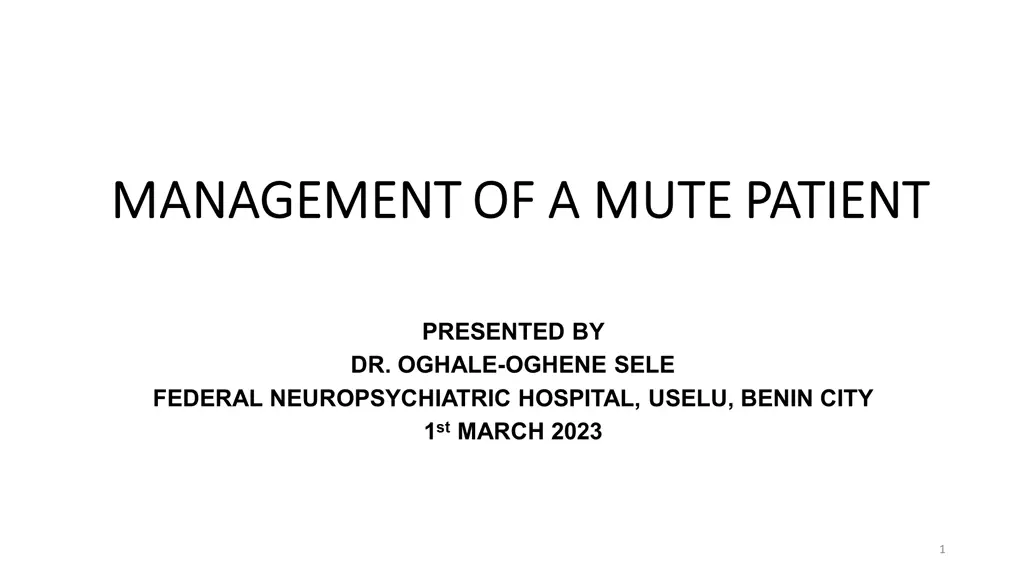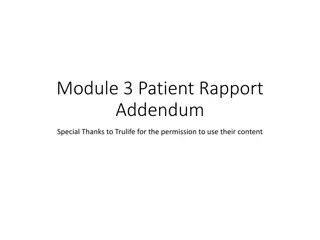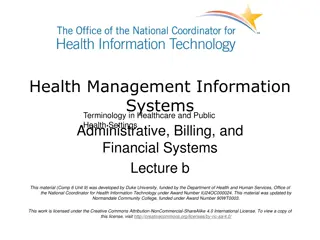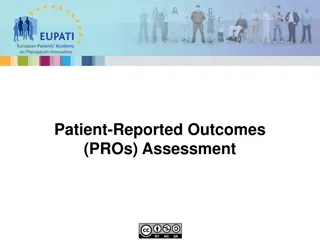Management of a Mute Patient
The differential diagnosis and management of mutism in patients. It covers the types of mutism, including elective mutism, selective mutism, and total mutism, and provides insights into the underlying psychological issues. The presentation also highlights the importance of proper diagnosis for effective management.
- mute patient
- management
- mutism
- diagnosis
- differential diagnosis
- treatment
- elective mutism
- selective mutism
Download Presentation

Please find below an Image/Link to download the presentation.
The content on the website is provided AS IS for your information and personal use only. It may not be sold, licensed, or shared on other websites without obtaining consent from the author. Download presentation by click this link. If you encounter any issues during the download, it is possible that the publisher has removed the file from their server.
E N D
Presentation Transcript
MANAGEMENT OF A MUTE PATIENT MANAGEMENT OF A MUTE PATIENT PRESENTED BY DR. OGHALE-OGHENE SELE FEDERAL NEUROPSYCHIATRIC HOSPITAL, USELU, BENIN CITY 1stMARCH 2023 1
OUTLINE Objective Introduction Differential diagnosis Management Conclusion References 2
OBJECTIVE To highlight the differential diagnosis of a mute patient. To discuss the management of a mute patient. 3
INTRODUCTION Mutism is a common clinical symptom seen in psychiatry as well as neurology outpatient department. Mutism occurs in association with other disturbances in behavior, thoughts process, affect or levels of consciousness. Mutism occurs in a number of conditions, both functional and organic and a proper management. diagnosis is important for 4
INTRODUCTION CONTD. DEFINITION Mutism is defined as inability or unwillingness to speak, resulting in an absence or marked paucity of verbal output 5
TYPES OF MUTISM The most common types of classifications include: Elective Mutism Selective Mutism Total Mutism 6
TYPES OF MUTISM CONTD. ELECTIVE MUTISM: A person chooses not to speak as a result of psychological issues. Someone s refusal to speak in almost all social situations (despite normal ability to do so). Elective mutism was often attributed to defiance or the effect of trauma . 7
TYPES OF MUTISM CONTD. ELECTIVE MUTISM CONTD: There are four subtypes of Elective Mutism. Symbiotic mutism: the most common of the forms, caused by a vocal and dominating mother and absent father (very rarely the other way around) and characterized by the use of mutism as controlling behavior around other adults. Speech phobic mutism: the least common, in which the child showed distinct fear at hearing a recording of their voice. This also involved ritualistic behaviors, which may reflect OCD, and was thought to be caused by the child having been told to keep a family secret. 8
TYPES OF MUTISM CONTD. ELECTIVE MUTISM CONTD: Reactive mutism: a reaction to trauma and/or abuse, with all children showing symptoms of depression and being notably withdrawn, usually showing no facial expressions. Passive-aggressive mutism: silence is used as a display of hostility, connected to antisocial behavior. 9
TYPES OF MUTISM SELECTIVE MUTISM Selective mutism is an anxiety disorder characterized by an inability to speak or communicate in certain social settings, such as at school, work, or in the community. The condition is usually first diagnosed in childhood. 10
TYPES OF MUTISM Total Mutism Total Mutism is when a person doesn't speak under any circumstance. 11
DIFFERENTIAL DIAGNOSIS OF MUTISM PSYCHIATRIC CAUSES: Schizophrenia Catatonia Affective disorder Major depression Bipolar disorder, manic Bipolar disorder, depressed Other psychotic disorders Schizophreniform psychosis Schizoaffective disorder 12
DIFFERENTIAL DIAGNOSIS OF MUTISM CONTD. PSYCHIATRIC CAUSES: Organic mental disorders Dementia Organic delusional syndrome Organic affective syndrome Substance use disorders Other disorders Conversion/dissociative disorders Factitious disorder Malingering Disorders of childhood Infantile autism Selective mutism Developmental failure (MR and deafness) 13
DIFFERENTIAL DIAGNOSIS OF MUTISM CONTD. DRUG INDUCED Drug-induced conditions Neuroleptic Malignant Syndrome Corticosteroids Antihypertensive agents Alcohol Aspirin 14
DIFFERENTIAL DIAGNOSIS OF MUTISM CONTD. NEUROLOGICAL CAUSES Cerebral cortex Alzheimer s disease Pick s disease Subdural hematoma Upper motor neuron Brainstem Mass in third or fourth ventricle, Lower motor neuron Cerebral hemorrhage Brainstem compression 15
DIFFERENTIAL DIAGNOSIS OF MUTISM CONTD. NEUROLOGICAL CAUSES Basal ganglia Parkinson s disease Huntingtons s disease Wilson s disease Limbic system Infarction Akinetic mutism Others Epilepsy 16
MANAGEMENT OF A MUTE PATIENT Taking a good history is important History will consist of biodata of the patient Some of the presenting complains may include refusing to respond when spoken to, staring blankly, unusual postures. PAST PSYCHIATRIC HISTORY Prior history of mutism or catatonia. History of bipolar illness, depression, schizophrenia, conversion disorder 17
MANAGEMENT OF A MUTE PATIENT CONTD. MEDICAL HISTORY Patient s medication list may highlight medical risk factors, e.g use of insulin, oral hypoglycemic, antihypertensive. Use of antiepileptic drugs should raise vigilance for absence seizures or postictal mutism. FAMILY HISTORY Family history of mental illness Patients relationship with close family members 18
MANAGEMENT OF A MUTE PATIENT CONTD. PERSONAL HISTORY Prior severe psychological trauma, post traumatic stress disorder or dissoactive state History of physical, social or emotional abuse. DRUG HISTORY History of use of psychoactive substances and alcohol. 19
MANAGEMENT OF A MUTE PATIENT CONTD. MENTAL STATE EXAMINATION Patient may appear rigid, eyes fixed, mute and maybe uncooperative. Affect maybe restricted. 20
MANAGEMENT OF A MUTE PATIENT CONTD. PHYSICAL EXAMINATION Neurological examination and proper physical examination of the patient should be done. Look for signs of posturing, stereotypy, waxy flexibility, rigidity, stupor. 21
MANAGEMENT OF A MUTE PATIENT CONTD. BIOLOGICAL INVESTIGATIONS Complete blood count E/U/CR Thyroid function test Blood glucose Urinalysis Toxicology screening EEG Brain imaging MRI 22
MANAGEMENT OF A MUTE PATIENT CONTD. PSYCHOLOGICAL INVESTIGATIONS Personality assessment IQ assessment 23
MANAGEMENT OF A MUTE PATIENT CONTD. SOCIAL INVESTIGATIONS Interviewing family to gain objective evidence of disturbed family dynamics Home visits to assess living conditions Satisfaction with job or school Any recent stressful events 24
MANAGEMENT OF A MUTE PATIENT CONTD. BIOLOGICAL TREATMENT Treat underlying illness and withdraw unnecessary medications Benzodiazepines Tab lorazepam. Mood stabilizers especially carbamazepine. Electroconvulsive therapy. Low potency atypical can be given e.g Tab aripiprazole, tab olanzapine. Treat underlying medical conditions. 25
MANAGEMENT OF A MUTE PATIENT CONTD. PSYCHOLOGICAL TREATMENT Abreaction Therapy Abreaction Therapy focuses on reliving a traumatic event and going through the emotions associated with them to heal and move forward 26
MANAGEMENT OF A MUTE PATIENT CONTD. PSYCHOLOGICAL TREATMENT Cognitive Behavioural Therapy (CBT) Among the most effective methods of treating symptoms of selective mutism is CBT. CBT helps change the clients thoughts (the cognitive part) and their actions(behavioural part). 27
MANAGEMENT OF A MUTE PATIENT CONTD. PSYCHOLOGICAL TREATMENT Behavioural Therapy This is a range of therapies which is based upon learning theories. All unhealthy behaviours(symptoms) are learned. These behaviours can be unlearned. Unlearning leads to relief of symptoms. 28
MANAGEMENT OF A MUTE PATIENT CONTD. SOCIAL TREAMENT Family support Community support 29
CONCLUSION Mutism is commonly seen in psychiatric patients and it is important to recognize the correct cause for proper management. One must have a high index of suspicion and look for various other non-psychiatric causes for mutism, management and prognosis of the patient. as this will decide the 30
REFERENCES https://bmcpsychology.biomedcentral.com/articles/10.1186/s40359- 022-00885-7 Mutism as the Presenting Symptom: Three Case Reports and Selective Review of Literature Ashish Aggarwal, Dinesh Dutt Sharma, Ramesh Kumar, and Ravi C. Sharma. Kaplan HI, Sadock BJ, editors. Comprehensive textbook of psychiatry. 9th ed. New York: Williams and Wilkins; 2009. [Google Scholar] 31
REFERENCES CONTD REFERENCES CONTD MacKinnon RA, Michels R. The psychiatric interview in clinical practice. Philadelphia: WB Saunders; 1971. [Google Scholar] Smith S. An investigation and survey of twenty-seven cases of akinesis and mutism (stupor) J Ment Sci. 1959;105:1088 94. [PubMed] [Google Scholar] Joyston-Bechal MP. The clinical features and outcome of stupor. Br J Psychiatry. 1966;112:967 81. [PubMed] [Google Scholar] 32
REFERENCES CONTD. Abrams R, Taylor MA. Catatonia, a prospective clinical study. Arch Gem Psychiatry. 1976;33:579 82. [PubMed] [Google Scholar] Altshuler LL, Cummings JL, Mills MJ. Mutism: review, differential diagnosis, and report of 22 cases. Am J Psychiatry. 1986;143:1409 14. [PubMed] [Google Scholar] 33
THANK YOU 34

























